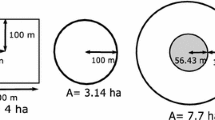Abstract
The use of heuristic techniques in forest planning has been promoted by the need to solve complex problems that cannot be solved using mixed integer programming. We proved that for merchantability standards ensuring the perfect bin-packing theorem (PBPT), the maximum volume that can be harvested annually equals the sum of the maximum MAI of the stands. The method accommodates optimality criteria at the stand level, regarded as maximum MAI, and at the forest level, regarded as maximum annual allowable cut. We scheduled the harvesting by adjusting the first fit decreasing algorithm (FFD) to the PBPT conditions. When PBPT conditions were not met, we developed a mixed integer programming solution to adjust the merchantability standards of the stands to the distributional requirements of the PBPT, an adjustment that ensured the optimal performance of the FFD. The adjusted FFD was compared with linear programming (LP) and simulated annealing (SA) using two harvesting ages (i.e., one based on MAI maximization and one determined as the minimal age) and the same set of spatial temporal constraints for three areas in north-eastern British Columbia, Canada. We found that the adjusted FFD performed 100 times faster than SA and for annual allowable cut (AAC) supplied results that were more homogenous and at least 10% greater than the AAC supplied by SA. Furthermore, the adjusted FFD seemed to be relatively insensitive to spatial constraints (i.e., adjacency), while SA displayed a 70% reduction in AAC in response to an increase in adjacency delay from 1 year to 20 years. The results suggest that both adjusted FFD and SA are impacted by the selection of the harvesting age, but the adjusted FFD could still outperform SA.





Similar content being viewed by others
References
Amacher GS, Ollikainen M, Koskela E (2009) Economics of forest resources. MIT Press, Cambridge
Anderson DR, Sweeney DJ, Williams TA (1994) An introduction to management science. Quantitative approaches to decision making. West Publishing Company, St. Paul
Baskent EZ, Jordan GA (2002) Forest landscape management modeling using simulated annealing. For Ecol Manag 165(1–3):29–45
Bettinger P, Graetz D, Boston K, Sessions J, Chung W (2002) Eight heuristic planning techniques applied to three increasingly difficult wildlife planning problems. Silva Fennica 36(2):561–584
Bettinger P, Sessions J, Boston K (2009a) A review of the status and use of validation procedures for heuristics used in forest planning. Mathematical and Computational Forestry and Natural-Resource Sciences 1(1):26–37
Bettinger P, Boston K, Siry J, Grebner DL (2009b) Forest management and planning. Academic Press, New York
Borland Software Corporation (2001) Delphi 7.0. Cupertino
Boston K, Bettinger P (1999) An analysis of Monte Carlo integer programming, simulated annealing, and tabu search heuristics for solving spatial harvest scheduling problems. Forest Science 45(2):292–301
Clements SE, Dallain PL, Jamnick MS (1990) An operational, spatially constrained harvest scheduling model. Can J For Res 20(9):1438–1447
Clutter JL, Forston JC, Pienaar LV, Brister GH, Bailey RL (1983) Timber management: a quantitative approach. Wiley, New York
Coffman EG, Garey MR, Johnson DS (1997) Approximation algorithms for bin packing: a survey. In: Hochbaum DS (ed) Approximation algorithms for NP-Hard problems. PWS Publishing, Boston, pp 46–93
Coffman EG, Courcoubetis C, Garey MR, Johnson DS, Shor PW, Weber RR, Yannakakis M (2000) Bin packing with discrete item sizes, Part I: perfect packing theorems and the average case behavior of optimal packing. SIAM Journal of Discrete Mathematics 13(3):384–402
Coffman EG, Courcoubetis C, Garey MR, Johnson DS, Shor PW, Weber RR, Yannakakis M (2002) Perfect packing theorems and the average-case behavior of optimal and online bin packing. SIAM Review 44(1):95–108
Crowe K, Nelson J (2003) An indirect search algorithm for harvest-scheduling under adjacency constraints. Forest Science 49(1):1–11
Crowe K, Nelson J, Boyland M (2003) Solving the area-restricted harvest-scheduling model using the branch and bound algorithm. Can J For Res 33(9):1804–1814
Csirik J, Johnson DS (2001) Bounded space on-line bin packing: best is better than first. Algorithmica 31(2):115–138
Csirik J, Johnson DS, Kenyon C, Shor PW, Weber RR (1999) A self organizing bin packing heuristic. In: Goodrich MT, McGeoch CC (eds) Algorithm engineering and experimentation. Lecture Notes in Computer Science 1619, Springer, Berlin, pp 246–265
Davis LS, Johnson KN, Bettinger P, Howard TE (2001) Forest management, 4th edn. McGraw-Hill, New York
Dawson Greek LRMP Working Group (1999) Dawson creek land and resource management plan. Rep. 31090-25-01. Ministry of Sustainable Resources Management, Victoria
Devroye L (1986) Non-uniform random variate generation. Springer, New York
Duerr WA (1993) Introduction to forest resource economics. McGraw-Hill, New York
Fort Nelson LRMP Working Group (1997) Fort Nelson land and resources management plan. Ministry of Sustainable Resources Management, Victoria
Fort St. John LRMP Working Group (1997) Fort St. John land and resources management plan. Rep. 31090-25-04. Ministry of Sustainable Resources Management, Victoria
Garey MR, Graham RL, Johnson DS, Yao ACC (1976) Resource constrained scheduling as generalized bin packing. Journal of Combinatorial Theory Series A 21(3):257–298
Geman S, Geman D (1984) Stochastic relaxation, Gibbs distributions, and the Bayesian restoration of images. IEEE Transactions on Pattern Analysis and Machine Intelligence 6:721–741
Goycoolea M, Murray AT, Barahona F, Epstein R, Weintraub A (2005) Harvest scheduling subject to maximum area restrictions: exploring exact approaches. Operations Research 53(3):490–500
Gunn EA, Richards EW (2005) Solving the adjacency problem with stand-centred constraints. Can J For Res 35(4):832–842
Hastings WK (1970) Monte-Carlo sampling methods using Markov Chains and their applications. Biometrika 57(1):97–109
Heinonen T, Pukkala T (2004) A comparison of one- and two-compartment neighbourhoods in heuristic search with spatial forest management goals. Silva Fennica 38(3):319–332
Heyer CJ (1841) Die Waldertragsregelung. Verlag B.C. Ferber, Giessen
Hoffman P (1998) The man who loved only numbers. Hyperion, New York
Hoos H, Stutzle Y (2005) Stochastic local search. Morgan Kaufmann Publishers, New York
Hundeshagen JC (1826) Die Forstabschätzung aufneuen wissenschaftlichen Grundlagen. H. Laupp, Tübingen
Johnson DS (1973) Near-optimal bin packing algorithms. Dissertation, Massachusetts Institute of Technology
Jukes W, Menzies D, Rosen D, Taylor G, Saint-Jean R, Beale J (2004) Sustainable forest management plan. Fort St. John
Kangas AS, Kangas J (1999) Optimization bias in forest management planning solutions due to errors in forest variables. Silva Fennica 33(4):303–315
Kangas J, Kangas AS, Leskinen P, Pykäläinen J (2002) MCDM methods in strategic planning of forestry on state-owned lands in Finland: applications and experiences. Journal of Multi-Criteria Decision Analysis 10(5):257–271
Liu G, Han S, Zhao X, Nelson JD, Wang H, Wang W (2006) Optimisation algorithms for spatially constrained forest planning. Ecol Model 194(4):421–428
Lockwood C, Moore T (1993) Harvest scheduling with spatial constraints: a simulated annealing approach. Can J For Res 23(3):468–478
Mathey AH, Krcmar E, Tait D, Vertinsky I, Innes J (2007) Forest planning using co-evolutionary cellular automata. For Ecol Manag 239(1–3):45–56
McDill ME, Rebain SA, Braze J (2002) Harvest scheduling with area-based adjacency constraints. Forest Science 48(4):631–642
Metropolis N, Rosenbluth AW, Rosenbluth MN, Teller AH, Teller E (1953) Equations of state calculations by fast computing machines. J Chem Phys 21(6):1087–1092
Murray AT (1999) Spatial restrictions in harvest scheduling. Forest Science 45(1):45–52
Murray AT, Church RL (1995) Heuristic solution approaches to operational forest planning problems. OR Spektrum 17(2–3):193–203
Nemhauser GL, Wolsey LA (1988) Integer and combinatorial optimization. Wiley, New York
Nyland RD (1996) Silviculture. Concepts and applications. McGraw-Hill, New York
Ohman K, Lamas T (2005) Reducing forest fragmentation in long-term forest planning by using the shape index. For Ecol Manag 212(1–3):346–357
Optimal Software (2001) C-Whiz. Sterling
Pedersen L (2003) AAC Rationale for the Fort St. John TSA. Ministry of Forests, Victoria
Pukkala T, Kurttila M (2005) Examining the performance of six heuristic optimisation techniques in different forest planning problems. Silva Fennica 39(1):67–80
Rhee WT (1991) Stochastic-analysis of a modified first fit decreasing packing. Mathematics of Operations Research 16(1):162–175
Rucareanu N, Leahu I (1982) Amenajarea padurilor. Ceres, Bucharest
SAS Institute Inc. (2004) SAS Software 9.1.3. Cary
Shanks ME, Gambill R (1973) Calculus. Holt, Rinehart and Winston, Inc., New York
Ullman JD (1971) The performances of a memory allocation algorithm. Technical Report 100. Princeton
USDA Forest Service (2009) Spectrum. 3.0. Fort Collins
Wah BW, Wang T (1999) Simulated annealing with asymptotic convergence for nonlinear constrained global optimization. In: Jaffar J (ed) Principles and practice of constraint programming. Springer, New York, pp 461–475
Wolsey LA (1998) Integer programming. Wiley, New York
Zomaya AY, Kazman R (1999) Simulated annealing techniques. In: Atallah MJ (ed) Handbook on algorithms and theory of computation. CRC Press, Boca Raton, pp 37-1–37-19
Acknowledgments
We would like to thank Bruce Meneghin from the USDA Forest Service, Planning Analysis Group, for his help in the usage of Spectrum, and two referees that helped to improve the article discourse and presentation. The research was partially supported by Sustainable Forest Management Network, Canada.
Author information
Authors and Affiliations
Corresponding author
Additional information
Communicated by T. Knoke.
This article belongs to the special issue “Linking Forest Inventory and Optimisation”.
Appendix
Appendix
Corollary
For a predetermined set of merchantability standards ensuring PBPT fulfillment, the maximum even-flow volume that can be harvested annually is equal to the sum of the maximum mean annual increment of the stands.
Proof
The perfect packing theorem ensures that the MVHA can be reached by harvesting a selected yearly combination of stands if, and only if, the total volume of all stands at optimal harvesting age (OHA) is a multiple of MVHA. Therefore, the maximum amount of timber that can be harvested when perfect bin-packing conditions are fulfilled is
Where R is the rotation period, N is the number of stands used for MVHA computation, V ij is the volume of stand i harvested at age j, X ij is a binary variable identifying where or not the stand i was harvested at age j, and k is a positive integer ensuring the equality (5).
The planning period needs to be determined exactly as the bin-packing theorem operates in discrete non-stochastic settings. Therefore, concepts as the mean, median or mode of OHA cannot be used to represent forest rotation as some stands would require harvesting a non-integer number of times during rotation, violating PBPT settings. The perfect bin-packing theorem restricts R to values that ensure that all stands are harvested an integer number of times during rotation. The smallest possible number that satisfies this condition is the smallest common multiplier of the OHA. Thus, the forest rotation is determined as:
where R 1,…., R s = the decomposition factors of OHA for each stand, derived from numbers theory, a i j = the exponent of the decomposition factor R j corresponding to OHA of stand i, OHA i , \( {\text{OHA}}_{i} = R_{1}^{{a_{1}^{i} }} R_{2}^{{a_{2}^{i} }} \ldots R_{s}^{{a_{s}^{i} }} \) for stand \( i \in \{ 1,2 \ldots ,N\} \), s = the number of distinct decomposition factors among all OHA i
The smallest common multiplier ensures that each stand is harvested an integer number of times during forest rotation but transforms R into a pseudo-rotation, as each stand will be harvested at least once in R years. The number of times stand i is harvested during this pseudo-rotation period is R/OHA i :
During the rotation period R the total harvested volume is \( V = \sum\limits_{i = 1}^{N} {{\frac{R}{{{\text{OHA}}_{i} }}}} V_{{i,{\text{OHA}}_{i} }} \).
Therefore,
where \( {\text{MAI}}_{{i,{\text{OHA}}_{i} }} \) is the mean annual increment of stand i at OHA i [q.e.d.]
Rights and permissions
About this article
Cite this article
Strimbu, B.M., Innes, J.L. & Strimbu, V.F. A deterministic harvest scheduler using perfect bin-packing theorem. Eur J Forest Res 129, 961–974 (2010). https://doi.org/10.1007/s10342-010-0405-0
Received:
Revised:
Accepted:
Published:
Issue Date:
DOI: https://doi.org/10.1007/s10342-010-0405-0




